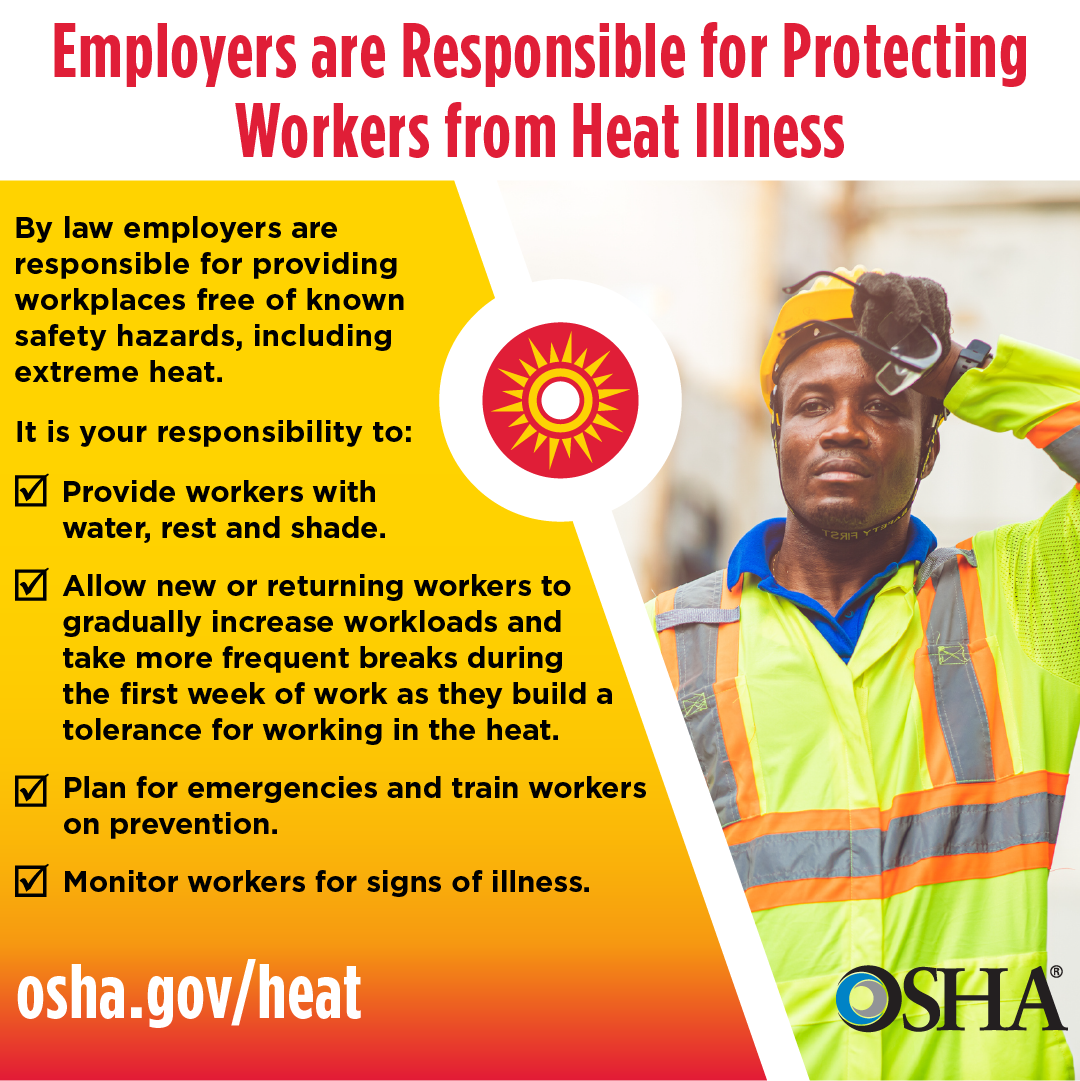OSHA HEAT SAFETY GUIDELINES FOR EMPLOYERS AND THE WORKPLACE
The Temperatures in Las Vegas (& Nevada in General) Are Heating Up
Summer hasn’t even officially begun, and Las Vegas is currently experiencing its hottest June on record. And the rest of Nevada isn’t faring much better with fire weather watches and warnings are becoming more frequent already in Northern Nevada. Air temperatures will get intensely hot across the state over the next few weeks and months, and with that comes the need for us to exercise caution. The Occupational Safety and Health Administration has introduced a new OSHA heat safety campaign for employers to ensure they are providing safe working conditions for all their workers.
What Regulations Must Employers Follow to Ensure Heat Safety and Mitigate Risk Levels in the Workplace?
Legally, the short answer is ‘not many,’ except to provide potable water. One of our members recently called the HR Hotline to ask if they were required to provide sunscreen for their outdoor workers. They were surprised to learn that providing this or other protective measures is not federally mandated.
Nevada OSHA has been working on a proposed regulation to mandate certain protective regulations, but so far this has not come to pass. The federal requirements outlined in the OSHA heat protection guidelines do not cover much beyond providing drinking water and the typical breaks. However, this may change soon as lawmakers seek to expand regulations to more specifically cover weather-related concerns.
What Should Employers do to Ensure Worksite Safety in the Summertime?
As of now, there are a few clauses that expand on what is currently in the books regarding occupational safety that could be applied to cover extreme weather management and heat related illness prevention.
The main clause being the “general duty clause.” This clause means that employers have a duty to provide their employees with a safe place to work, free of hazards. The clause reiterates that it is the employer’s responsibility to ensure that precautions are followed to reduce personal risk of their workers, and extreme heat exposure is considered a workplace hazard under this clause.
OSHA’s Heat Safety Campaign

OSHA has introduced the Heat Illness Prevention campaign which seeks to educate workers and employers on exposure risks and heat protections in the workplace. This is part of a larger campaign to ensure that heat protection laws are passed and that employers know their responsibilities to their employees.
Some Employer Responsibilities Outlined in this Campaign Include:
- Providing workers with easy access to shade , water, and encourage regular rest breaks.
- Allowing new or returning workers to gradually increase their workloads and take more breaks as they begin the acclimatization process to get used to strenuous physical activity
while dealing with more extreme weather conditions. - Planning for emergencies and training workers on prevention.
- Monitoring workers and staying alert for signs of illness such as exhaustion, dehydration, heat stroke.
Taking OSHA Heat Safety into Your Own Hands
In the meantime, to ensure you are compliant with the “general duty clause”, and to prepare for further OSHA Heat Safety laws when they pass, here are some recommendations to keep your employees safe in the elements:
- Create a heat safety policy. This can include things like water breaks, providing shade, taking extra breaks during outdoor work activities, if needed, working earlier or later hours to avoid the sun exposure, PPE recommendations, such as hats, neck coolers, and moisture wicking shirts, and hosting safety meetings about working outside.
- Consider building a budget to provide accessibility to certain items for your employees in the summer, such as sunscreen, water, hats, portable fans, shade providing devices, and hot weather wear.
- Provide training to your employees on paying attention to weather advisories, recognizing the symptoms of exposure related illnesses such as heat stress, exhaustion, and sunstroke, and providing first aid when these symptoms are recognized.
There are many useful resources available to create and maintain programs around summer and working in the outdoor elements, in general. These include OSHA, NIOSH (National Institute for Occupational Safety and Health), and, in Nevada, the SCATS (Safety Consultation and Training Section) program provides many free resources to employers who are interested in creating a safe work environment for their employees.
The National Weather Service also has a heat safety page that you can use to keep tabs on any warnings that may be issued when it comes to outside temperatures.
You can even download the OSHA NIOSH Heat Safety Tool App on your phone. It is a useful resource for planning outdoor work activities based on how hot it feels throughout the day. It has a real-time heat index and hourly forecasts specific to your location.
Workplace Safety is Always a Priority
Remember that keeping your employees safe should be a priority, particularly for those who are working outside in extreme conditions. Ultimately, if you, as an employer, have the resources to provide additional tools and PPE, set protocols, or facilitate training for your employees to ensure health and protection on extremely hot days, it is your duty to do so.
Mailing List Sign Up Form
Fill out this mailing list sign up form to receive monthly email updates on the latest NAE news, HR issues, special events, training dates and more!
